What are Rameshwaram (Jyotirlinga) history (facts) | Rama Setu construction | Why Rama installed Linga at Rameshwaram
Namaste friends, how are you doing today? Welcome to #BhagavanBhakthi website / blog.
Bhagavan Lord Sri Rama (Narayana) (Vishnu) (Krishna) blessings to you and your family!
In this website / blog, you will always learn about #Hinduism #Sanskrit language.
Also subscribe to my YouTube channel from this link #BhagavanBhakthi to view videos about #Hinduism #Sanskrit language.
Just before moving towards to know about “What are Rameshwaram (Jyotirlinga) history (facts) | Rama Setu construction | Why Rama installed Linga at Rameshwaram“, let us know few basic and important information.
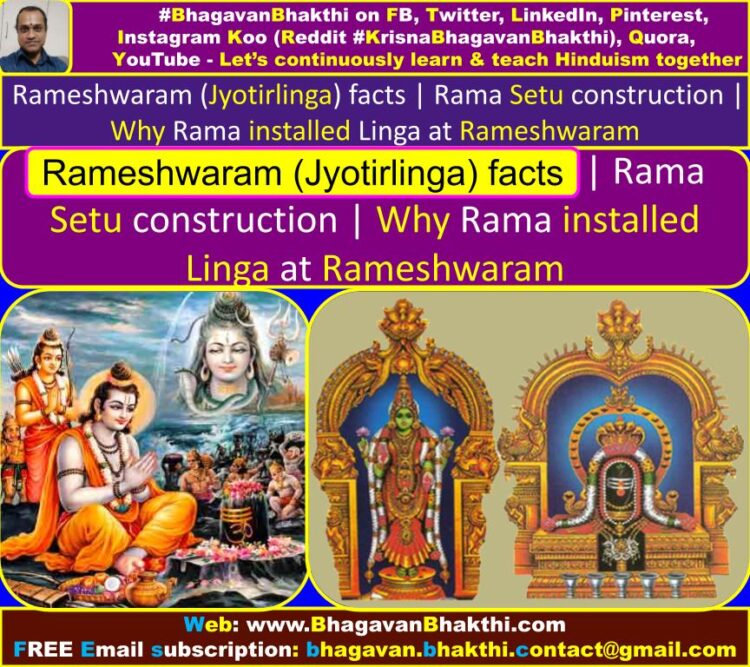
Lord Sri Rama after slaying Ravana and his demon group, and also after freeing Sri Sita Deva,
came back to a southern India (Present Tamil Nadu) and installed a divine Linga called Rameshwaram or Ramanatha.
This divine temple is still existing in today’s Tamil Nadu, India.
This divine and most auspicious temple is one of the 12 Jyotirlingams in India.
A Jyotirlingam or Jyotirlinga or Jyotirling, is a divine representation of Lord Shiva.
The word Jyotirlingam or Jyotirlinga or Jyotirling is a Sanskrit word.
Jyotirlingam or Jyotirlinga or Jyotirling means jyoti or ‘divine illumination’ and Linga means Lord Shiva’s Linga.
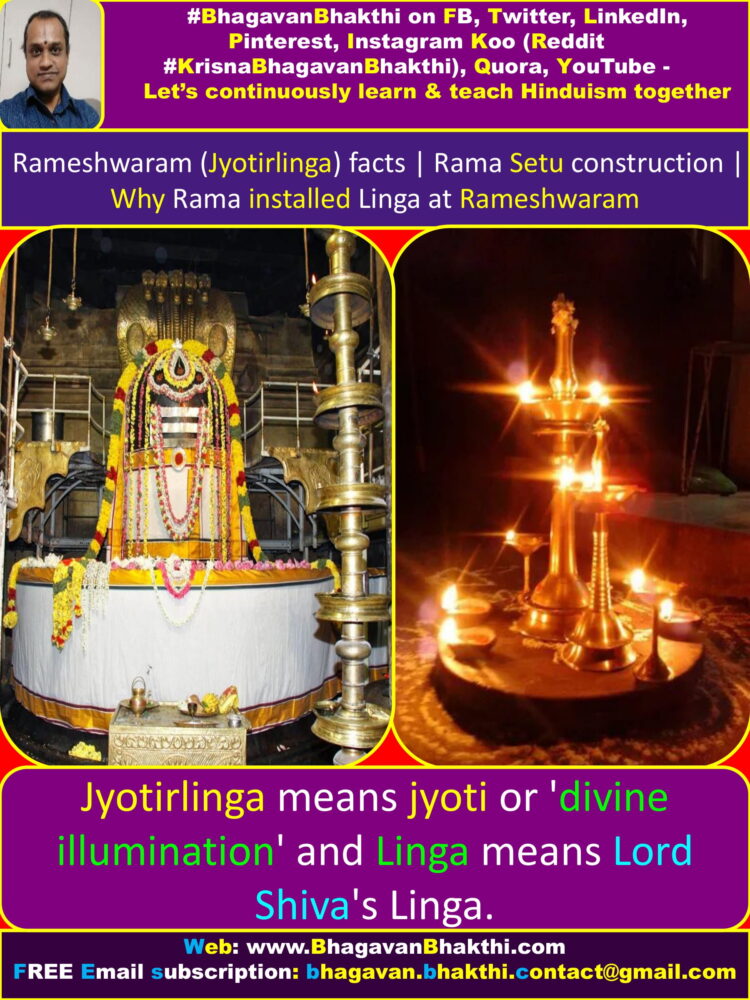
Shiva Purana mentions 64 original Jyotirlinga shrines in India and Nepal.
In these, 12 are the most auspicious Lingas of Lord Shiva and thus these are also known as ‘Maha Jyotirlingams‘ or ‘Dwadasha Jyotirlingas‘.
The 12 (Dwadasha) Jyotirlingams of Lord Shiva are as given below:
Nageshwar : नागेश्वर / nāgēśvara – Gurajat – Near Dwaraka
Vishwanath : विश्वनाथ / viśvanātha – Uttar Pradesh – Varanasi
Vaidyanath : वैद्यनाथ / vaidyanātha – Jharkhand – Deoghar
Grishneshwar : घृष्णेश्वर / griṣṇēśvara – Maharashtra – Aurangabad
Rameshwaram : रामेश्वरं / rāmēśvaraṁ – Tamilnadu – Rameshwaram
Trimbakeshwar : त्रिंबकेश्वर / trimbakēśvara – Maharashtra – Nashik
Bhimashankar : भीमाशंकर / bhīmāśaṅkara – Maharashtra – Bhimashankar
Kedarnath : केदारनाथ / kēdāranātha – Uttarakhand – Kedarnath
Omkareshwar : ओंकारेश्वर / Ōṅkārēśvara – Madhya Pradesh – Khandwa
Mahakaleshwar : महाकालेश्वर / mahākāḷēśvara – Madhya Pradesh – Ujjain
Mallikarjun : मल्लिकार्जुन / mallikārjuna – Andhra Pradesh – Kurnool
Somnath : सोमनाथ / sōmanātha – Gujarat – Saurashtra

List of Rameshwaram history (facts) are as given below:
Rameshwaram is one of the 12 Jyotirlingas
Rameshwaram Linga was installed by Sri Rama
Rameshwaram can give moksha
Holy dip at Setu Rameshwaram gives Vishnulokam (Vaikuntha)
Sleeping at sea shore frees us from Brahma Hatya Dosham
Person will be blessed if remains are consigned to the holy waters at Rameshwaram after death
Rameshwaram Setu length is 100 yojana and it is 10 yojana broad (wide)
Many holy places are present
And many more…

Story about Rameshwaram
Once, Shaunaka Maharshi and few other sages asked Sutaji, as to how could a man become free from the bondage of the world.
They also inquired whether there was an existence of any such holy place capable of liberating a man from heinous of sin.
Sutaji replied: ‘Ramateertha (Rameshwaram) is supreme among all the places of pilgrimage.’
‘A mere sight of this holy place is enough to free a man from the bondage of this mortal world.’
‘Going on a pilgrimage to Rameshwaram gives virtues similar to what is attained by performing all the yagyas.’
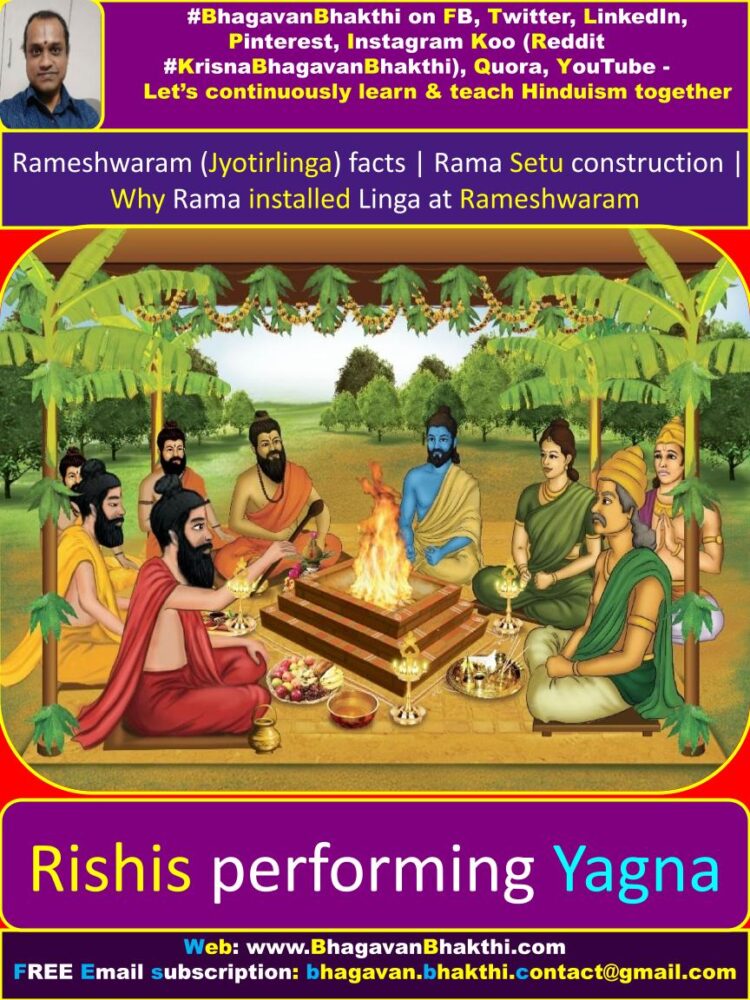
‘One, who takes a holy dip at Setu Rameshwaram, attains to Vishnuloka (Vaikuntha).’
‘Merely by sleeping at the sea shore of Rameshwaram, a man gets absolved of heinous of sins like brahma hatya dosham, etc.’
‘A man is blessed if his remains are consigned to the holy waters at Rameshwaram after his death.’
‘Scriptures say that five types of sins are as grave as the sin of brahma hatya dosham as given below’:
1. One, who criticizes sages
2. A selfish person who cooks food only for himself
3. One who destroys well laid path making it difficult for people to tread upon
4. One who accepts food from a ‘chandala‘ and
5. One who sells food grains to a chandala.

But, all these just disappears once the sinner reaches Rameshwaram.
About Setu Bandhana (Construction of Rama Setu)
All the sages were curious to know about the holy places in the vicinity of Rameshwaram.
Sutaji replied: Lord Sri Rama went into exile accompanied by Sri Sita Devi, his consort and his younger brother, Lakshmana.
Ravana, the demon king who ruled over Lanka deceitfully abducted Sri Sita Devi.
Subsequently, Lord Sri Rama befriended Sugriva and killed Vali, who harbored enmity against him.
Sugriva sent monkeys in all directions to find out where Sri Sita Devi had been kept by Ravana.
Later when Lord Sri Rama reached Mahendra Parvata accompanied by Lakshmana, Hanuman, Sugriva, Jambavan, Nala and may more brave warriors.

They all stayed for a brief period at Chakratirtha, where Vibhishana came to see Lord Sri Rama.
Eventually Vibhishana was nominated the king of all the demons (King of Lanka) by Lord Sri Rama,
to the great displeasure of his brother Ravana and Vibhishana was made the King of Lanka.
Lord Sri Rama and his army faced an uphill task of reaching Lanka,
as they had to cross the ocean, which lay as a great barrier between them and their destination.
Samudra Deva (Ocean Demigod) (Lord Sri Varuna Deva) revealed to Lord Sri Rama that –
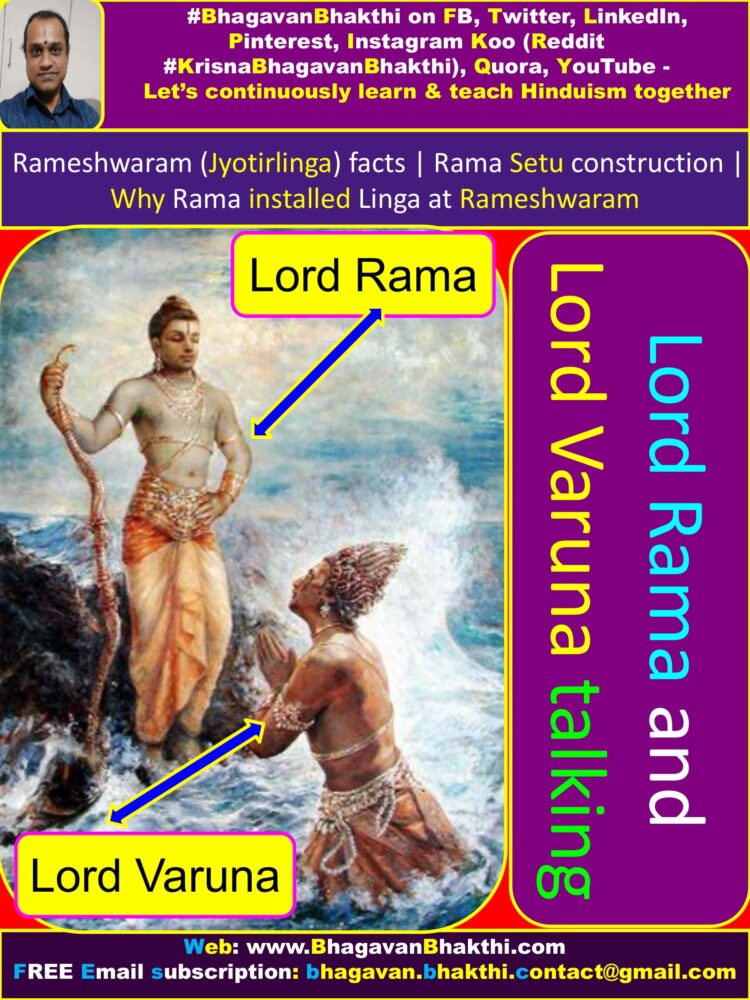
Nala had divine powers and whatever he would throw in the Ocean will not sink down, but keep on floating.
Nala tried to check the authenticity of Samudra’s (Lord Sri Varuna Deva) statement by throwing a huge rock into the ocean, as he himself was not aware of his powers.
[Note : Nala was an avatar of Lord Sri Vishwakarma, the architect of the Devatas (Demigods).]
To the sheer amazement of everybody present there, the rock started floating on the surface of the ocean instead of sinking down.
All the rest of the monkeys tried to emulate Nala’s feat by throwing huge rocks into the ocean and to their own surprise found that the rocks did not sink.
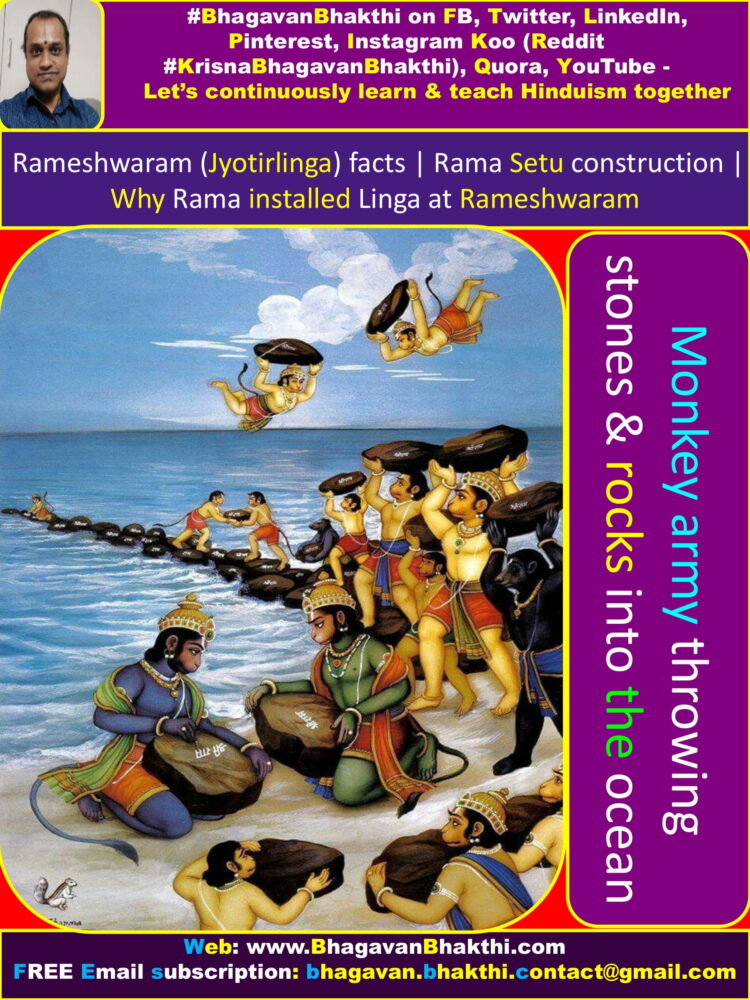
This was how a bridge was built and across the ocean which made it possible for Lord Sri Rama and his army to cross the ocean.
The length of ‘Setu Rameshwaram Bandhana (Rama Setu)‘ is hundred yojana and it is ten yojana broad (wide).

There are many holy places situated at the Rameshwaram, prominent among are as given below:
1. Chakratirtha
2. Papa Vinashana Tirtha
3. Sita Sarovara
4. Mangala Tirtha
5. Amrita Vatika
6. Brahma Kunda
7. Hanuman Kunda
8. Agastya Tirtha
9. Rama Tirtha
10. Lakshmana Tirtha
11. Jaya Tirtha
12. Lakshmi Tirtha
13. Agni Tirtha
14. Shiva Tirtha
15. Shankha Tirtha
16. Yamuna Tirtha
17. Ganga Tirtha
18. Koti Tirtha
19. Manasa-teertha
20. Dhanushakoti teertha
About RAMESHWARAM LINGA
Describing how Lord Sri Rama had installed Rameshwaram Linga, Sutaji said:
‘After killing Ravana, Lord Sri Rama enthroned Vibhishana as the king of Lanka.’
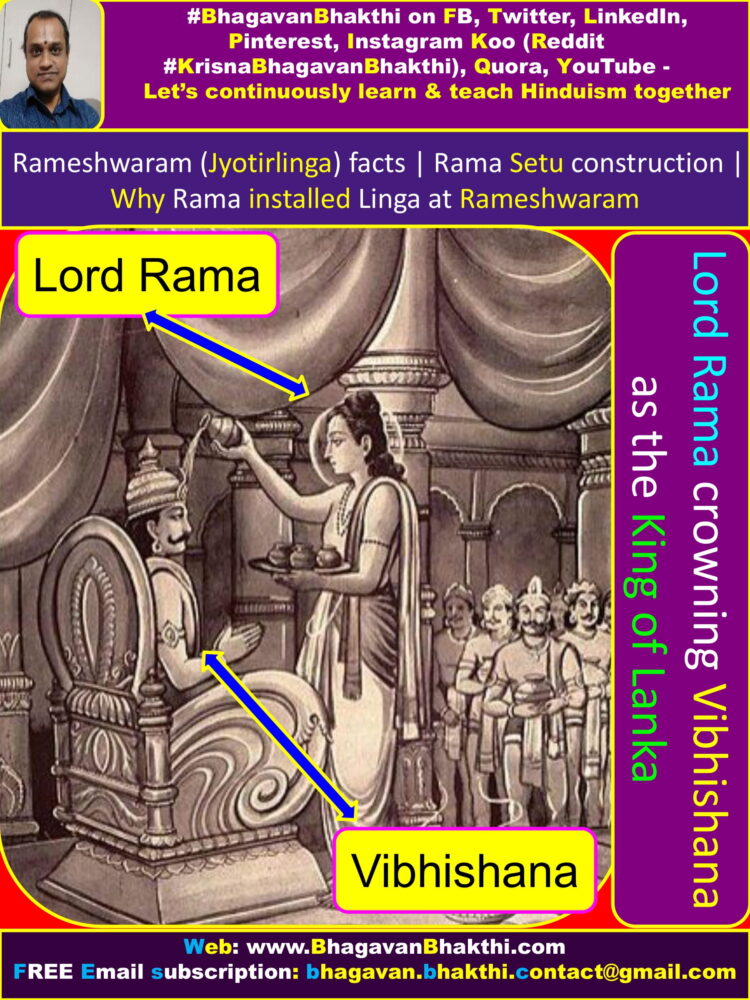
‘While returning to Ayodhya Lord Sri Rama made a brief stop at Gandhamadana mountain.’
‘Since the thought of having killed a brahmin (Ravana) kept on tormenting Lord Sri Rama, Lord Sri Rama decided to atone for his sins.’
‘So, he installed the idol of Rameshwaram Linga at Rameshwaram.’
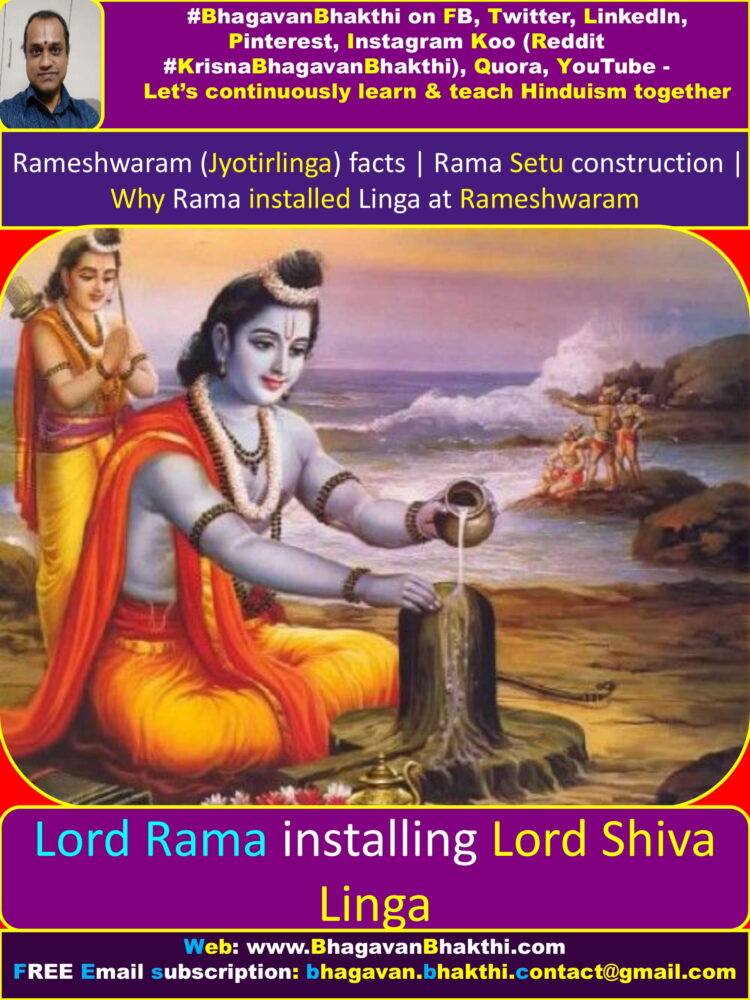
‘Rameshwaram Linga is so sacrosanct that all the holy places, sages and ancestors are believed to exist within the temple premise of Rameshwaram Linga.’
‘Being installed by Lord Sri Rama himself, this particular Linga has special significance attached to it.’
‘One who goes on a pilgrimage to this holy place, is certain to attain salvation (moksha) (A place in Vaikuntha),’
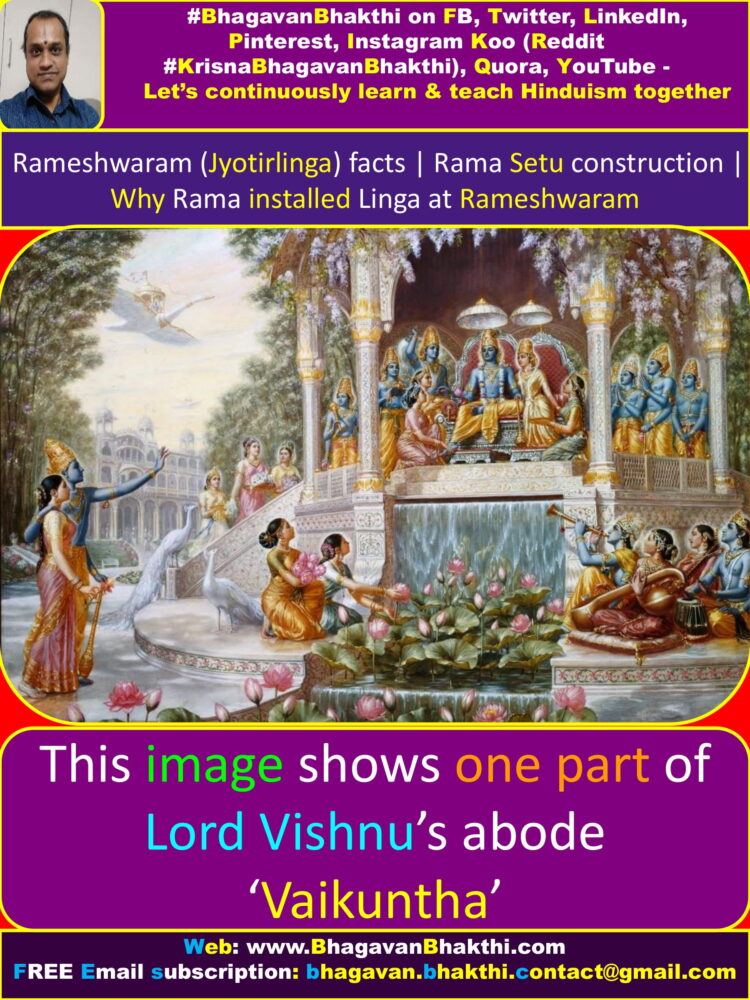
‘even if he were a ‘Mlechha‘ (born in a family who eat cow’s meat and one who doesn’t follow Dharma at all).’
PS: We should always remember that, Lord Sri Rama is Svayam Bhagavan / Ishvara / Parameshvara / Parabrahma.
He is called as “Atma Kama“, that is, he doesn’t need anybody to fulfill his desires and he doesn’t need to make others happy.
In fact all others starting from Sri Mahalakshmi Devi, Sri Brahma Deva, Sri Rudra Deva etc. etc. etc. all are followers of Lord Sri Rama / Sri Krishna.
Whatever Sri Hari (Vishnu) (Rama) (Krishna) has instructed, all such instructions has to be obeyed by all.

Also we should note that, Lord Sri Rama, he only shows the way for the common person to follow, that means –
Lord Sri Rama shows us the path if one does one or more sins, that person has to do so and so Karmas to get rid of those sins.
Lord Sri Rama (Sri Krishna) doesn’t need to pray anybody and he never follows anyone, as he is svayam Bhagavan, ‘THE SUPREME‘.
More information will be added to this on regular basis.
Please this post and other posts of this website / blog to get the updated information.
To watch videos on #Hinduism #Sanskrit language, SUBSCRIBE to my YouTube channel from this below link:
#BhagavanBhakthi YouTube channel
To know “Ramayana unknown facts“, you can visit my another post with the below link:
To know about the “Suryavanshi (Solar dynasty) (Suryavamsha) family tree (members) names“, please click the below link:
Suryavanshi (Solar dynasty) (Suryavamsha) family tree (members) names
To know about the “Chandravamsha (Chandravansh) (Chandravanshi) (Lunar lineage) Family Tree“, you can click the below link:
Chandravansh (Chandravanshi) (Chandravamsha) (Lunar dynasty / lineage) Family Tree
Dear friends, if you need any clarifications about this post, kindly let me know, I will definitely try to answer all of them.
Also your one LIKE, one COMMENT, One Share, one SUBSCRIPTION is highly important.
This will help to know the quality of this content and also it will be helpful to know if any improvements is required for the content.
If you feel this content is useful to you and has helped you to improve your knowledge, kindly share this with your well-wishers.
Because “SHARING MEANS CARING”.
For receive FREE EMAIL SUBSCRIPTION about #BhagavanBhakthi, you can send an email to [email protected] from your email ID.
NAMASTE!
SRI GURUBHYO NAMAHA
OM NAMO NARAYANAYA
Sri Krishnaarpanamastu